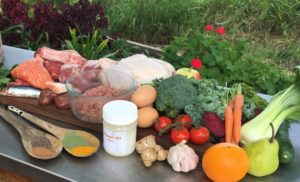
When you look at the evolution of dogs, they have certainly evolved and differentiated physically quite substantially over time.
It is undeniable that a German Shepherd and a Chihuahua look vastly different, but does this mean they are as diverse on the inside?
Despite physical characteristics that differentiate one breed of dog from another, dogs and wolves belong to the same genus (Canis) and share 99.9% of their DNA. These similarities can be identified in notable shared characteristics, like digging and foraging, social behaviours and ways of communicating.
When it comes to diet, the jaw structure of canines gives us an indication of the diet that matches their physiology and the evolution of dogs in the wild to eat and thrive. Dogs’ teeth and jaws are adapted to a carnivorous diet with teeth that are designed for capturing and dismembering prey.
The length and function of the dogs’ digestive system also indicates that they were born to eat raw meat and absorb their nutrition primarily from the body parts of their prey with a small additional component of their diet coming from plant matter which includes grasses, seeds and fruits.
To us humans, some of the more “undesirable” parts of an animal are the most delicious and nutritious to canines! In the wild, the first things to go are the internal organs of prey which harbour the most concentrated levels of vitamins and minerals. Organs like liver, kidneys, heart and brain are concentrated sources of fat soluble vitamins like A, D, E and K.
Wolves will consume skin, fur and bones as well as muscle meat in their ancestral diet. In larger prey, the stomach contents may be shaken to remove the bulk of the contents as a natural precautionary instinct, but the lining of the digestive system which is rich in natural probiotics would be consumed.
With all of this in mind, a species appropriate diet takes into account the evolution of dogs and the evolutionary diet of canines. This is the modern version of the way our domesticated dogs would eat, if they were still in the wild.
A species appropriate diet is broken down into is broken down into the following:
Raw Meat – Raw meat and fats derived from a variety of animals. These provide digestible sources of protein and iron and make up the largest portion of the diet. Protein is the largest source of amino acids which are used as the basic building blocks of cells in the body.
Offal – Organ meat including liver, kidney, heart, spleen and pancreas contain proteins and deliver a plethora of essential vitamins and minerals.
Bone – For concentrated levels of naturally occurring vitamins and minerals, nothing beats soft non-weight-bearing bones and cartilage for a natural source of calcium and phosphorus for teeth and bone health, zinc for immunity and omega-3 essential fatty acids to reduce inflammation.
Vegetable and fruit matter – Contain a naturally complete range of vitamins and minerals. Mostly green leafy and coloured vegetables, as well as fruits, ideally crushed and pulp to ensure better absorption. Together these supply antioxidants, phytonutrients, fibre and moisture as well as essential vitamins and minerals. Learn more about the benefits of vegetable and fruits here.
Other – In the wild this would be fur, stomach lining and organs like eyes and reproductive organs. In a modern day version of an evolutionary diet, ingredients like herbs, essential fatty acids, probiotics and prebiotics provide the nutrient profiles of some of these other components without quite so much of the “ick” factor.
Some of the concerns when it comes to raw feeding are the presence of pathogens, the quality and source of the ingredients and the processing methods. These concerns are no different to the way we look at the food we eat ourselves.
The number one query when it comes to raw food is, “isn’t there higher levels of bacteria present?” and the answer is yes, absolutely. Unless raw food has been sterilised, which often reduces the nutrient levels as much as the bacterial load, there will most certainly be higher bacterial counts when compared to cooked foods. Are these bacteria bad? For our pets, no they aren’t. Read more about the benefits of bacteria here.
The evolution of the dog means they have shorter digestive systems than we do, which are designed for foods to enter and exit quickly, not ferment like in a human digestive system. This reduces the time bacteria can sit in the system, replicate and thrive.
Furthermore, pets have highly acidic digestive systems with neutralise bacteria and dissolve bone, therefore more than capable of handling raw food. Even decomposing food poses little risk to our canine friends, often burying bones and food in the yard for a snack a little later on.
The time you might find your dog gets an upset stomach with a raw food diet, is if they are fed primarily a dry food diet, which makes their digestive system more alkaline, which is not natural for dogs. Read more about the impact of dry dog food here
Plus, it is important to always introduce any new diet to your dog slowly, so read more about transitioning your puppy or dog across to a new diet safely here.
The handling of raw pet food is no different to the rules we should follow when prepping raw food in our own homes before cooking. It is fundamental that when handling any raw food that safe food handling practices are followed, including washing hands, kitchen tools and work-spaces following preparing raw food to ensure the risk of cross-contamination is eliminated.
For those of you looking for a complete and balanced raw food diet, made from 100% human-grade, Australian ingredients and manufactured in alignment with safe food practices and appropriate industry guidelines, then visit the Big Dog Pet Foods website to learn more about the benefits of a raw food diet and our manufacturing processes.
We even let you behind the scenes into our factory so you can see exactly what goes into our dog’s food, how it is processed and why we are the leaders in our field.
A food science graduate, Chris Essex founded Big Dog Pet Foods in 2000 after many years working in the smallgoods industry, before he recognised a gap in the market to create pet food for dogs made up of bones and raw food that was full of nutritional ingredients. Visit www.bigdogpetfoods.com

Tips for preparing a raw food diet for your pet


Winter safety for dogs – Top Tips


Bladder Stones in Dogs and Cats


Get your paws on Lara Shannon’s best selling books ‘Eat, Play, Love (your dog) and World of Dogs.
Available in Australia, USA, UK and Canada.